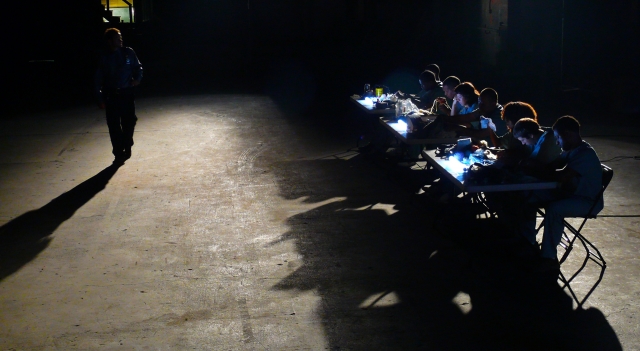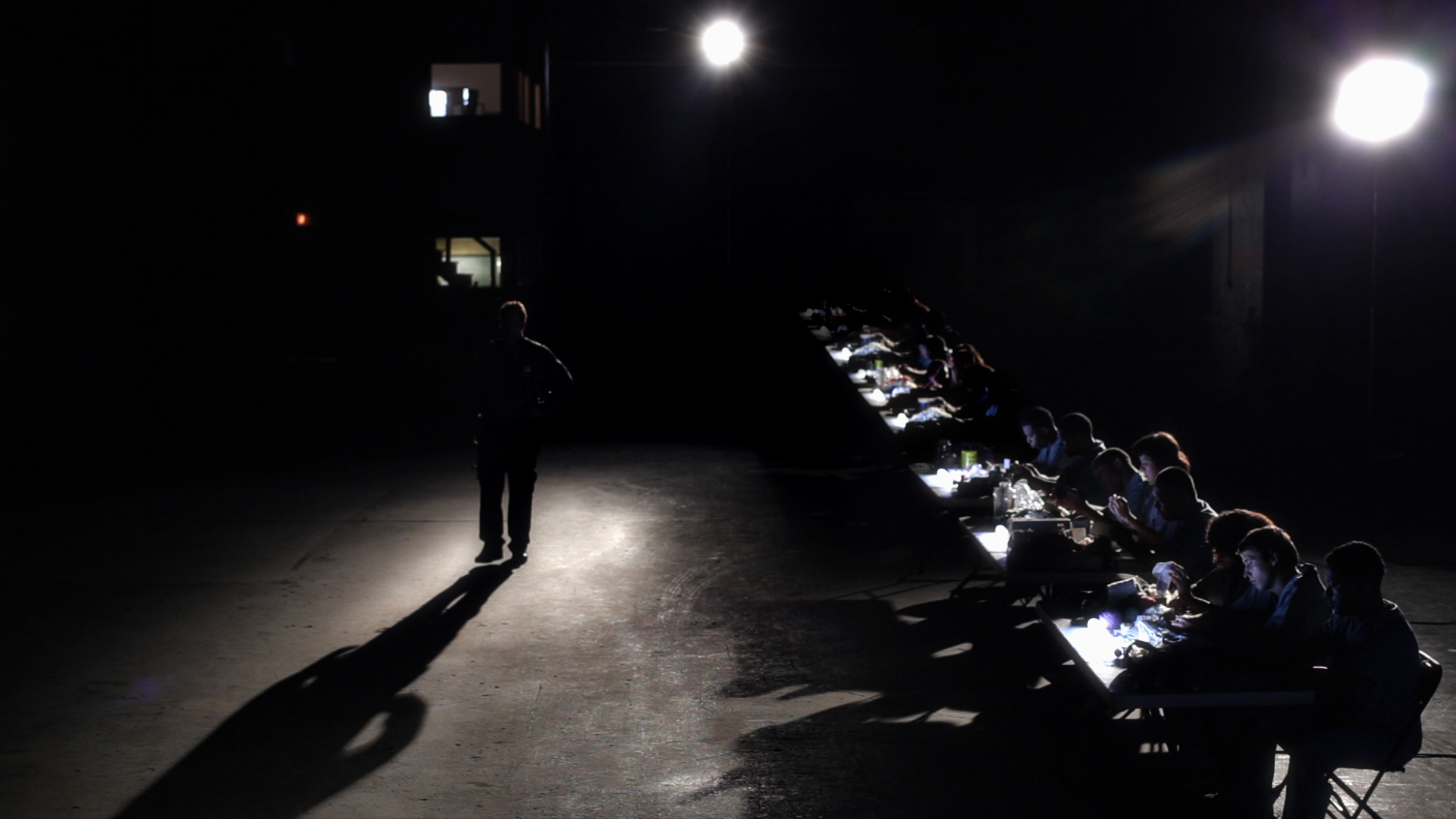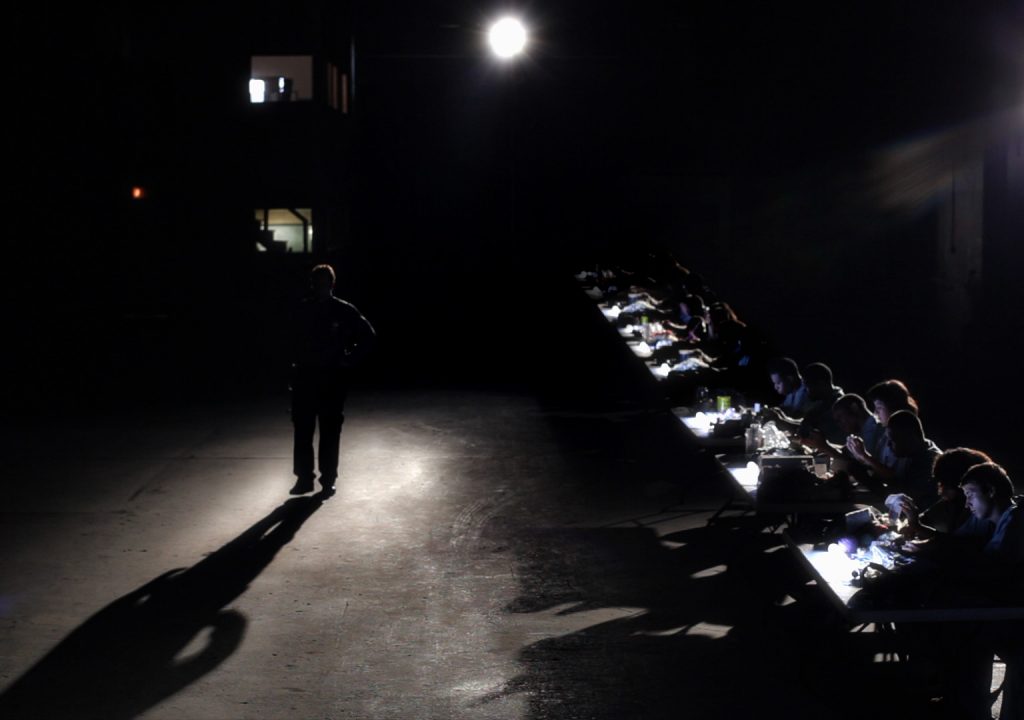This happens a lot: I’m budgeting a script and I get to this crowded street scene, or a basketball game, or a really killer dance set piece. I figure out as best I can how many extras are needed, and budget all the related costs accordingly. Then I present the budget to the producer and she’s horrified. “One hundred thousand for extras? What the hell?”

Fig. 1 Our first setup, with all our extras (and two principal actors) sitting at three tables. From Found In Time.

Fig.2 The final composited shot. 8 extras * 3 layers = 24 extras
Note: throughout this article I refer to background actors as extras, not to denigrate the profession, but because it’s a shorter term. I refer to SAG-AFTRA as SAG for the same reason.
Okay, so maybe I’m exaggerating, but not by much. Even if you don’t pay for extras, you have to think about them – where you need them, when you can get away without them, and how you’re going to cast, feed, clothe, and transport them. So in this article we’ll cover the basics of how to think intelligently about extras.
WHAT ARE EXTRAS?
Extras are there to fill in the background (hence the other term, background actors) of the scene, or be part of a group that’s in the foreground. A lot of producers think that if they take away lines from a minor character in the script, that they can fill that role with an extra. This isn’t always the case, however.
When breaking down and budgeting a script, I use this checklist to determine if a role is fit for an extra or an actor:
- Does the character have any lines?
- Does the character perform a stunt?
- Does the character interact with others in the script in any kind of complicated way?
- Does the character play a musical instrument or do a solo dance?
- Is the character prominent in a scene (a bartender at a bar can be a good example of this)?
- Does the director feel that this character is important/needs to be paid attention to?
- Is the character nude in the scene(s)?
If I’ve answered yes to any of the questions, I budget the role to be filled by an actor.
A borderline case is a dead body (on the street or in a funeral home or morgue). If the role is critical to the scene, it’s better to get a paid actor to fill it than an unpaid extra. Being dead is hard work.
If you have a role that requires a stunt, nudity, or a stunt being performed while nude, you have to hire an actor (preferably Viggo Mortensen) for the role.
Often the writer doesn’t mention extras at all or very vaguely (“a crowded street,” “a half-empty bar”). So I assume that the director will want some of them to fill up the following kinds of scenes:
- Sports events
- Classrooms
- Battle scenes
- Sidewalk/park/campus scenes
- Funerals/weddings/graduations
- Dances
- Malls
- Bars/Restaurants
- Chase scenes in a crowded space
- Campus/park/other wide-open spaces in an otherwise urban environment
When preparing the breakdown and budget I separate out the extras for each location and script day. If the script includes some camera directions or the director’s given me some idea of how she wants to shoot the scene (ie if we’re never going to see two-thirds of that restaurant, then I can trim the extras headcount accordingly).
For most non-sporting-event scenes, you’ll want to hire/find about 20%-25% of the number of people you’d actually need in order for the room to fill “full” in real life. Mid-sized classrooms are an exception. Because of the open furniture layout and number of desks, a classroom with 6 kids in it will look… like a classroom with 6 kids in it. But a club that would take 600 people to fill in real life can “look” full with 100 people or less, depending on how you shoot the scene.
For sporting events, you can try shooting wide shots at a real stadium, then hire a small group for close-ups to fill a small area.
OTHER TYPES OF EXTRAS
I also budget for the following additional types of extras, especially on larger budget shoots:
Stand-Ins: These poor folks have to stand on set while the cast get made up. They do rough blocking rehearsals for the benefit of the crew, so they can set the lighting, camera position, and mic placement. If you have children in leading roles, you really should budget for stand-ins (often the stand-ins are shorter adults), because the kids will get fidgety and anxious during this phase. Stand-ins get paid more than standard extras.
You don’t need to budget one stand-in per speaking role – usually two or three (at most) is enough for the entire shoot.
Special Ability Extras: Need a basketball team? Or a dance troupe? Depending on how involved the action is (i.e. if they’re not doing anything especially acrobatic), you can usually populate your team with extras who have these abilities. They get a bonus above and beyond the standard extra pay.
Body Doubles: These can be extras – if they don’t have to do stunts or nude scenes. If you have a child character in a leading role or you have a very narrow window to shoot an actor out on your film, it’s usually a good idea to budget for a body double. This way you can shoot all the character’s close-up and wide shots with the actor, and put the body-double in for the over-the-shoulder close-ups of the other character(s). Body doubles also get a bonus.
OTHER CONSIDERATIONS:
In addition to paying your extras, you have to think about other issues:
- Transportation: Are you shooting in an area where people can just walk to set, or will you have to pick them up and drop them off? If you have a lot of extras showing up on one day, you may have to rent extra vehicles and reserve more parking.
- Wardrobe: It’s reasonable to expect extras to show up in street clothes, and/or business casual. But if you’re asking them to be lawyers, or firemen, or (in the case of my film Found In Time) prisoners, you’ll have to supply the wardrobe. If an extra happens to have the specialty wardrobe you need, they get a premium for providing it. This is usually worth it, since their uniform will fit them better.
- Food: Extras feel, with justification, that they’re not treated as well as the cast and crew. Some low-budget shoots feed extras with pizza and other fast foods. Please don’t do this. The one area I think you might be able to trim back on is offering a full breakfast (see below). Keep in mind that providing good food is way of telling people that you care about them, so don’t go cheap just to save few bucks.
- Holding: I like to find a big room or hall on location so the extras can hang out when they’re not needed on set. If you can hook up a television and play some movies or at the news, get some newspapers, and keep some snacks handy, it will go a long way to keeping people from walking away out of boredom. Obviously, this hall/room needs to be factored into your location budget.
- Casting: Someone has to cast the extras, and call them with start times, pickup details, dress code, etc. If you don’t hire someone for this, it’ll fall on the production department’s back. Don’t expect your principal casting director to handle this for you for free.
- Wrangling: Someone has to call the extras to set, get them off the set, make sure they fill out their release forms and payroll paperwork, and try to keep them happy and informed. This can be a dedicated PA (hired for the “heavy days”) or it could end up being you and whoever else is available.
With a little planning and creative problem-solving, these things don’t have to break your budget.
FIRST MISTAKE: MY FRIENDS SAY THEY’LL BE EXTRAS
Every producer has a boatload of friends, relatives, work buddies, and students who are fascinated by/want to be in movies. The producer says these people will work for free. Don’t believe it. Unless they work for the producer and will be fired for not showing up, don’t count on these folks coming in and sitting around for more than a couple of hours. Even if they absolutely swear they will be there, anticipate a dropoff rate of about 75%.
SAG AND EXTRAS
Under the SAG Short, Ultra Low Budget (ULB) and Modified Low Budget (MLB) Agreements, you don’t have to hire SAG extras. Under the Low Budget Agreement and Basic Agreement, you have to book a certain number of SAG extras per day before you can book non-SAG extras. You can apply for waivers for large crowd scenes. On the west coast (including Las Vegas, LA, San Diego, and some other major cities) it’s 57 per day; in NY and the surrounding area, it’s 85 per day. In other areas, the requirements vary. Stand-ins are usually not counted towards the per requirement.
Here’s a breakdown of the SAG background actor’s pay, as of July 2014.
| Base Rate | 8 Hours | $151.00 | |
| Overtime | Hours, 9-10, 1.5x | 1.5x $18.875 | $56.63 |
| Doubletime | Hours 11-12, 2.0x | 2.0x$18.875 | $75.50 |
Total Pay: $283.13
| SAG Health Pension & Welfare: | 16.8% total | $47.57 | |
| Federal & State Payroll Fringes (avg): | 21% | $59.46 | |
| Payroll Company (avg): | 2% | $5.66 |
Total Per Day: $395.82
Additional perks that SAG extras get:
- Wet/smoke pay ‑ if they have to work in rainy conditions, or stand next to a smoke machine for hours at a time, they get a bump in their pay of $14/day
- Hazard pay – negotiated per “hazard.”
- Costume/makeup fittings – these are paid for as well
- Night shooting – between 8pm and 1am, this is a 10% bump; between 1am and 6am, 20%.
- Wardrobe allowance – extras are compensated for bringing second changes of wardrobe, formalwear (something that would require dry cleaning), and police/fireman uniforms
- Pets, special props, cars – if the extra provides these, you pay them various bonuses
Visit SAG’s website, www.sagaftra.org for more info on SAG background actor pay and rules.
If you’re making a micro-budget feature, you may simply not be able to afford SAG extras. But there are some advantages to hiring them. You’ll get folks who are experienced, know when to show up and what to do when they get there. They also know not to take set photos, not to distract the crew and cast, or do other things that can get in your way.
HOLY CRAP HOW DO I DO THIS
You’re probably starting to realize that your epic indie with all those big bar fight scenes may be tougher to shoot for $50K than you thought. But don’t despair. Here are a few solutions that can save you some money.
WORK WITH A LOCAL AGENCY
Talent agencies with rosters of non-union actors can help you out, in exchange for a commission (usually 10%) of the earnings. If you’re up front about what you can afford, they’ll often be able to work with you. You also won’t have to do the extras casting yourself.
CALL THEM IN LATER / DISMISS THEM EARLY
It’s a bad idea to start your day with a big extras-heavy scene anyway, so call them in later than the cast and crew. This can save you from renting additional vehicles, as well. Instead you can repurpose the crew/cast vans to go pick up your extras. You can also offer a lighter breakfast.
Likewise, try not to end your day with your big extras scene. You can drop off your extras with your existing cast/crew vans as well.
PAY IN CASH
Assuming no individual extra is going to get more than $600 per year from your shoot, you can pay in cash and save yourself some payroll fringes.
WORK WITH FOLKS IN TOWN
When working outside NYC, I’ve been able to get cops, bar patrons, hospital workers, and soldiers to work as some version of themselves in the film. In most places, if you say you’re shooting a movie people want to get involved, even as extras. So if you can do something special for them – buy them drinks at the bar afterwards, show them how the set works, get your lead to sign a few autographs, feature their favorite place’s sign in the film, let them see some dailies – you can often get people to work for free.
CONTACT A LOCAL THEATER COMPANY
This can sometimes backfire, particularly if the actors in the company expect to show up and play principal roles, but if you’re very specific and tell them what to expect, it can be a great experience for everyone.
USE THE CREW (SPARINGLY)
The crew usually have a lot of other things to do, but it’s okay to ask a couple of them to appear here and there.
BUDGET SOME FREE EXTRAS
You can usually count on at least a few of the producer’s friends to come by. I assume that 10-20% of the total extras headcount will come in for free.
EXPECT SOME FREE EXTRAS FROM THE STREET
About half of Found In Time takes place on a busy NYC street corner. We didn’t have the manpower or budget to control the corner, so we expected – in fact, wanted – some people to walk by. We just asked people not to look at the camera (which sometimes had the opposite effect) and either got release forms or held up signs warning people that they could expect to be photographed.
SHOOT/BLOCK SMART
If you’re shooting multiple sports games, concerts or dining hall/restaurant scenes, repositioning your extras from scene to scene and slightly changing up their wardrobe (jacket on, jacket off) will allow you to hire fewer total extras. If you can’t fill an entire stadium/hall, cluster them together for the close-ups, then spread them out a bit for wider shots.
For dance/church/big conference scenes, talk to the DP and director when you get closer to shooting about how they see the scene. You can often get away with clumping a smaller number of extras in strategic spots to create the illusion of a larger crowd. Remember that wide angle lenses generally accentuate distances between subjects whereas telephoto lenses collapse them.
SHOOT “REAL” AUDIENCES / BACKGROUND SEPARATELY
You can shoot reaction/cutaway shots on the street or in a public space (like a stadium or park) with a splinter or second unit. If you negotiate ahead of time with a theater, church or other non-public space you can also shoot reaction shots. Be sure to get signed release forms when shooting in “normally” non-public spaces. At the very least post warning signs telling people that you’ll be shooting in a certain part of the space.
COMPOSITING EXTRAS
If you have a situation where you have to fill a large space and don’t have enough people, you can simply “repeat” your extras. That’s what we did on Found In Time. We locked down our camera, and shot a setup with three tables full of extras in the foreground. Then we moved the tables down the field and re-sat the extras in different positions. In post we then extended the set one more time (digitally shrinking the extras and tables). The result was that we were able to make eight extras and one principal sitting at three tables look like 27 people sitting at 12 tables.
FOOD AND EXTRAS
Always budget for extra snack money when you have a lot of extras. I also recommend dedicating a PA (or bringing one on for the day) to watch over and keep the extras happy.
When it comes to lunch, I firmly believe that everyone on set (cast, crew, extras, location owners, etc.) should eat the same food. If you start feeding extras fast food, you’ll create an “us vs. them” dynamic that could easily result in a few of them not coming back after lunch. Sometimes it may be necessary to seat the extras in their own area, if they outnumber the cast and crew.
EXTRAS ARE PEOPLE
The big thing to remember is that extras are real people, one of the reasons SAG/AFTRA calls them background actors. They are helping you make your movie, so you should treat them as you would treat anyone else on your crew or cast.
Images courtesy of the production crew: Cinematographer: Ben Wolf. Visual Effects: Vickie Lazos. Colorist: Verne Mattson
More from Arthur Vincie:

